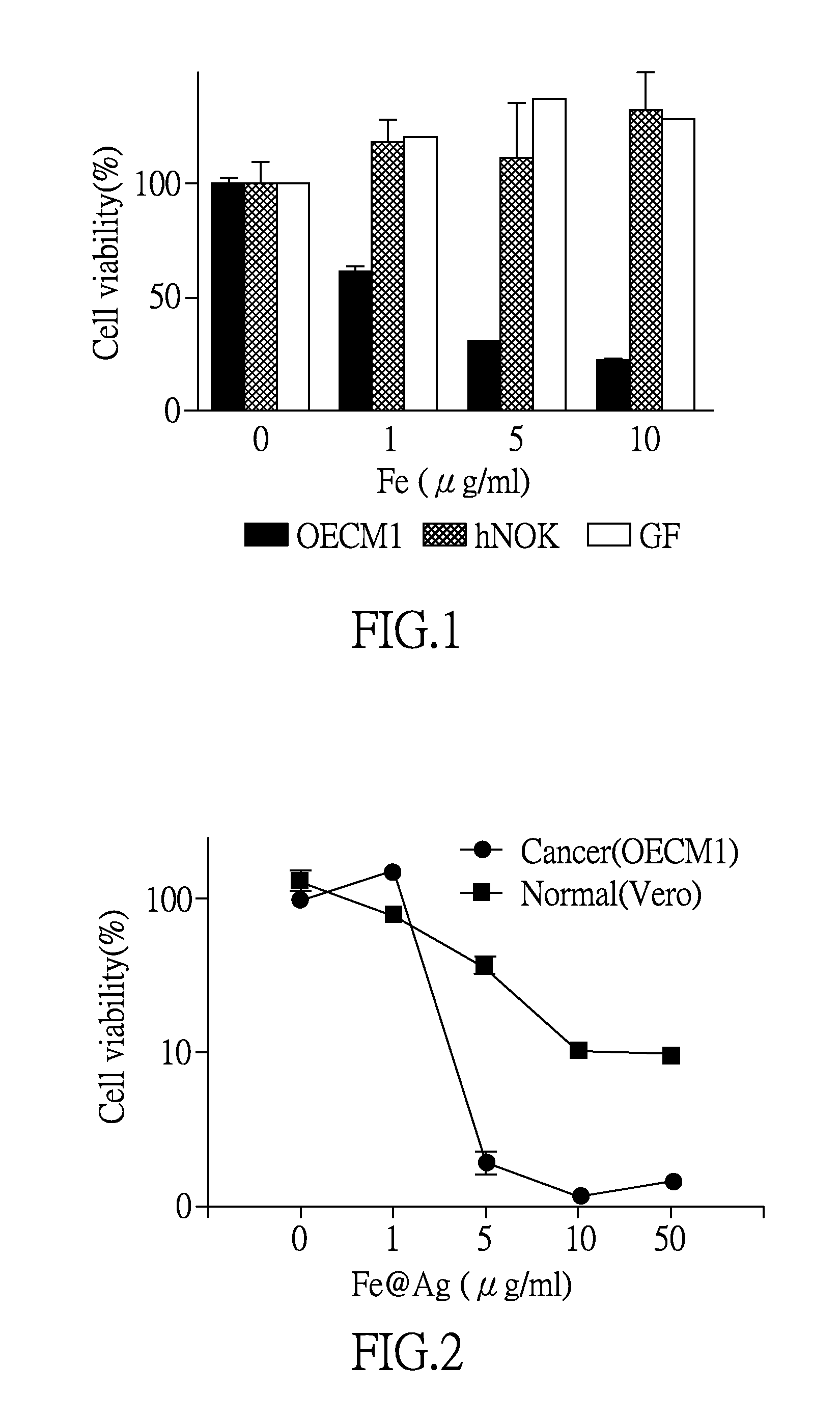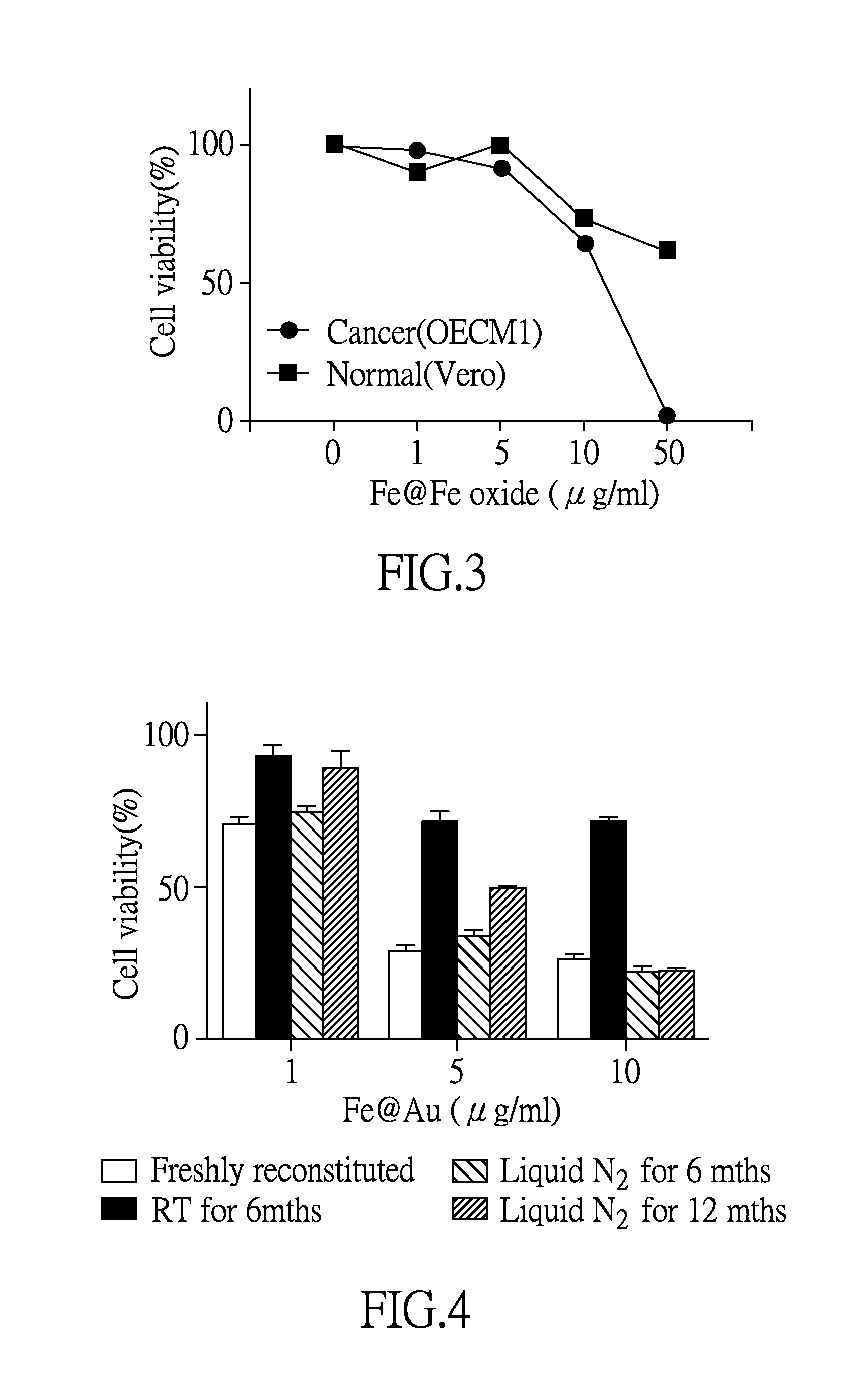Method for treating cancer by using Fe-based particles
a technology of fe-based particles and cancer, applied in the field of cancer treatment, can solve the problems of limitations of agents
- Summary
- Abstract
- Description
- Claims
- Application Information
AI Technical Summary
Benefits of technology
Problems solved by technology
Method used
Image
Examples
embodiment 1
Preparation of Fe-Based Particles with Zero Valent Irons
[0029]To synthesize the Fe-based particles, 20 mL 1-octadecene and 0.3 mL oleylamine was mixed at 120° C. for 30 min in argon. Later, 0.7 mL iron pentacarbonyl was added to the 1-octadecene and oleylamine mixture at 180° C. for 20 min with continuously argon condition. The solution was cooled down to 160° C. before the further addition of 0.15 mL iron pentacarbonyl. Then, the solution was aged at 160° C. for 30 min with the presence of 0.3 ml oleic acid (1 mM). The particles were then washed with hexane and ethanol, and then kept in argon prior to the use.
[0030]Here, the Fe-based particles were placed in desiccated inert gas to prevent Fe being oxidized. The Fe-based particles also can be placed in a liquid with low reactivity such as oxygen-depleted alcohol to prevent oxidation.
[0031]After the aforementioned process, the Fe-based particles were obtained, which are Fe elemental particles with zero valent irons. Herein, the size...
embodiment 2
Preparation of Fe-Based Particles with an Fe Elemental Core and Ag Coating Layer (Fe@Ag)
[0032]4.6 mM of ferrous sulfate and 0.46 mM of trisodium citrate dehydrate was mixed by stirring. The 8.8 mM of sodium borohydride was added into the mixture and stirred for another 10 min at room temperature. 0.05 M silver nitrate was further added into the mixture and then stirred for 5 min at room temperature in argon. The particles were then washed with ethanol for 3 times and collected via a magnet.
[0033]After the aforementioned process, Fe-based particles with Fe elemental cores and Ag coating layers as shells were obtained, in which the Ag coating layer was disposed on the whole surface of the Fe elemental core in each Fe-based particle. Herein, the size of each Fe-based particle is about 84.86±17.35 nm, the shape thereof is in sphere, and the thickness of the Ag coating layer is about 5 nm.
embodiment 3
Preparation of Fe-Based Particles with Fe Elemental Core and Iron Oxide (Fe2O3) Shell (Fe@Iron Oxide)
[0034]To synthesize the Fe(iron oxide particles, 20 mL 1-octadecene and 0.3 mL oleylamine was mixed at 120° C. for 30 min in argon. Later, 0.7 mL iron pentacarbonyl was added to the 1-octadecene and oleylamine mixture at 180° C. for 20 min with continuously argon condition. The solution was cooled down to 160° C. before the further addition of 0.15 mL iron pentacarbonyl. Then, the solution was aged at 160° C. for 30 min with the presence of 0.3 mL oleic acid (1 mM). The particles were then washed with hexane and ethanol, and then kept in argon prior to the use. Herein, the iron oxide (Fe2O3) shell was formed spontaneously in a suitable environment, so the process for forming iron oxide shell can be omitted.
[0035]After the aforementioned process, Fe-based particles with Fe elemental cores and iron oxide coating layers as shells were obtained, in which the iron oxide coating layer was ...
PUM
| Property | Measurement | Unit |
|---|---|---|
| size | aaaaa | aaaaa |
| size | aaaaa | aaaaa |
| size | aaaaa | aaaaa |
Abstract
Description
Claims
Application Information
 Login to View More
Login to View More - R&D
- Intellectual Property
- Life Sciences
- Materials
- Tech Scout
- Unparalleled Data Quality
- Higher Quality Content
- 60% Fewer Hallucinations
Browse by: Latest US Patents, China's latest patents, Technical Efficacy Thesaurus, Application Domain, Technology Topic, Popular Technical Reports.
© 2025 PatSnap. All rights reserved.Legal|Privacy policy|Modern Slavery Act Transparency Statement|Sitemap|About US| Contact US: help@patsnap.com


